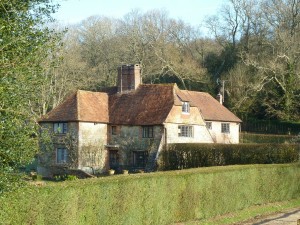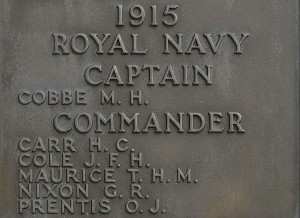Service: Royal Navy
Date of enrolment: 15 January 1894
Date & place of birth: 2 July 1880 in Wyke Regis, Dorset
Date & place of death: 7 November 1915 (aged 35) in Pentland Firth
George Russell Nixon had served in the Royal Navy for 21 years when he was swept off the bridge of the ship in which he was serving in heavy weather in the Pentland Firth.
Family background
George Russell Nixon was born in Wyke Regis, Dorset on 2 July 1880. He was the sixth of fourteen children (of whom two died as children) of Lieut. Col. Francis W Nixon, Royal Engineers, who was born in Sandwich, Kent, and his wife Edith Eliza née Malet, originally from India.
In 1881 the Nixon family of mother and father, five children, a governess and servants were living at 2 Lorne Villas, Wyke Regis, Dorset.

By 1891, there were nine children living at home but the family had moved to The Poplars, Stanley Road, Elstree. As George’s father was in the Royal Engineers the family had moved house on a number of occasions with postings to Cape Town, Bermuda, Dorset and Netley in Hampshire.
George married Ethel Bloodworth in the summer of 1912 at Thornbury in Gloucestershire. At the time of his death, Ethel lived at Commonside, Rogate.
Military service
George joined the Royal Navy on 15 January 1894 and was appointed a Midshipman on passing out of Britannia in April 1896. He was promoted from Sub-Lieutenant to Lieutenant on 1 January 1902. He took part in the Somaliland Operations between 1902-04 while on HMS Hermione. He then qualified as a Torpedo Officer and was promoted to Lieutenant Commander in December 1909. The 1911 Census shows that George was serving on HMS Black Prince, a 1st Class Armoured Cruiser of the 5th Cruiser Squadron of the Atlantic Fleet, which was then at Gibralter. After suffering a back injury. he spent a long time in either Haslar or Osborne House, but by August 1914 he was declared fit.
In June 1915 he was promoted to Commander and was serving on board HMS Albermarle, a pre-dreadnought Duncan class battleship. On 6 November 1915, HMS Albermarle left Scapa Flow to sail to the Mediterranean in company with a division of the 3rd Battle Squadron. At 02.27 on the morning of the 7 November, while in the Pentland Firth, the ships encountered extremely heavy weather and Albermarle, heavily loaded with spare ammunition, was struck by two large seas in rapid succession and suffered severe damage. The seas wrecked her forebridge and chart house, shifted the roof of her conning tower and flooded her forward main gun turret, mess decks and flats.
Death and commemoration

Commander George Russell Nixon and Able Seaman George Stroud were lost overboard. Chief Petty Officer Aiken was also killed and three officers and sixteen men seriously injured by wreckage. Two of the injured ratings later died. Albermarle accompanied by Zealandia and assisted by Hibernia returned to Scapa Flow for repairs and to transfer the injured men to the hospital ship Plassey for further treatment.
He is commemorated on the Rogate War Memorial and also the Portsmouth Naval Memorial.
His brother Oswald Nixon is also commemorated on Rogate War Memorial. He served in 70 Squadron of the Royal Flying Corps and was killed in action on 17 September 1916.